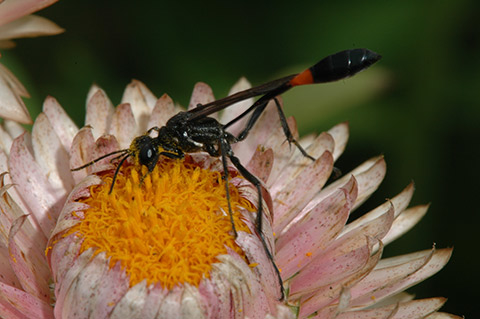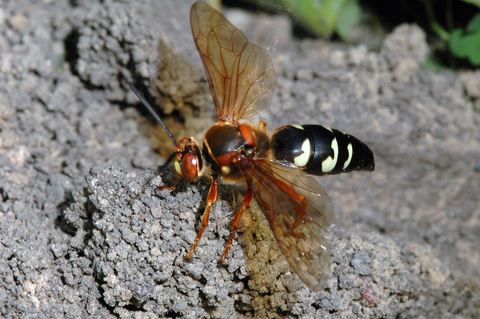When you think of wasps, you probably think about trying to enjoy food or drink outside on a warm fall day and being bothered by yellowjackets. Maybe you think of getting stung. These experiences are common and make it easier to disregard (or disdain) a class of insects that do Minnesotans a lot of good.
Wasps: More than an outdoor dining pest
The last few years have brought a new appreciation for the wide diversity of bees in Minnesota. Wasps have similar diversity, and arguably provide even more beneficial services than bees. The yellowjackets and paper wasps that spike many people’s anxiety are only a small portion of the wasp species seen in Minnesota.
Big wasp, small wasp, yellow wasp, blue wasp
Wasps include more than just yellowjackets and hornets. Like bees, some wasps are social and live in colonies, while others are solitary. There are approximately 103,000 species of wasps in the world. Only 1,000 of these are social, while the others are either solitary or parasitoids (more info on that later).
These wasps help the world’s ecosystems function, as wasps pollinate flowers, control pests, spread seeds and help decompose carcasses. They inspire artists (Antman and the Wasp anyone?) and in other parts of the world, are eaten as a delicacy. As we learn more about bees and how useful they are, it is only fair that we give some love to their often misunderstood, but equally helpful, relatives, wasps.
Every wasp species helps Minnesota ecosystems (and gardens) function
Wasps pollinate
Wasps’ fuzzier relatives, bees, often get credit for all pollination. Studies have shown that wasps are also good pollinators, and in some cases even step up and pollinate plants when bees are absent. Great black wasps are solitary wasps responsible for some pollination in Minnesota and individuals are often found on flowers.
Wasps help control garden pests
People often think of wasps as aggressive, and some insects probably share this feeling. Many wasp species feed on a wide variety of food sources, ranging from nectar and pollen to other insects. Some wasps are very targeted in what they hunt, seeking out and feeding on only one species of insect. Other species of wasps are generalists, meaning they will feed on whatever insects are available.
Social wasps, like yellowjackets and hornets, feed on a wide variety of insects, with studies finding social wasps eating flies, caterpillars, beetles and flies. One study in New Zealand tried to figure out how many pounds of insects a species of social wasps was hunting and eating, eventually estimating that the wasp colonies were eating an average of 2.12 pounds of insects per 2.47 acres. That’s a lot of bugs!
Solitary wasps may feed on other insects too. The great black wasp is also called cricket or katydid wasp, because they will feed their young crickets and katydids.
Wasps help control invasive species
Emerald ash borer is an invasive pest with major consequences for Minnesota’s forests and neighborhoods. Maybe your neighbors have been preventatively removing or treating their ash trees to protect trees, people and property from this pest. One option for longer-term control and slowing its spread, especially in Minnesota’s forests, are species of parasitoid wasps.
A parasitoid wasp is a wasp species with a specialized life-cycle. They target another species of insect and lay their eggs inside of them. The eggs hatch and the larvae feed on the other insect from the inside out, killing the host insect when they become adults (if this makes you think of the scene in the film Alien, you aren’t too far off).
These wasps are great at controlling pests because they are often specialized to lay eggs on one singular species. A bonus is that they are small and solitary, which means they aren’t defensive of a colony, do not sting humans, and aren’t usually noticed by people. Three parasitoid wasp species have been released in Minnesota to try to control emerald ash borer.
There are similar efforts underway to find wasps to help manage another unwelcome fall visitor, the brown marmorated stinkbug, as well as the berry menace spotted wing drosophila.
Okay, but why won’t they leave me alone come fall?
The only wasps bothering you in the fall are a small subset of Minnesota wasps, the social wasps.
Unlike honeybees where the goal of their social society is to have all members make it through the winter, only a yellowjacket queen makes it through winter. By the time the fall rolls around, the wasp colony contains thousands of members, and food supplies often aren’t adequate. This leads workers to aggressively scavenge for food, which often leads them to our food.
It is easier to modify our behaviors than get the wasps to modify theirs. Keeping calm and ignoring the wasps limits potential stings.
Yeah, but I still don’t want them near my house.
Totally fair, especially if the nest is in a high traffic area. This is a good time of year to keep an eye out for yellowjacket nests, as they start small and will be much easier to deal with than if you try to tackle the problem later in the year. For tips on removing different types of wasps nests, see the University of Minnesota Extension webpage about wasps and bees.
Again, keep in mind that our social wasp colonies survive only one year. The workers die in freezing temperatures while mated queens leave their old nests and search for protective places to spend the winter. This means winter is a great time to remove visible wasp nests, because they are vacant at that point.
What about 'murder hornets'?
The northern giant hornet (aka murder hornet), has not been found in Minnesota, and only has been found in a small area of Washington state.
There are some native insects that may seem similar. The cicada killer wasp is also very large. Cicada killer wasps are not dangerous, even though they can look intimidating. Females don’t instinctively protect their nests and generally ignore people. They can sting, but only do so if threatened. Males display aggressive behavior, but lack a stinger. Cicada killer wasps play a role in our Minnesota ecosystems by bringing cicadas down into their nests in the soil and feeding on them.
Brock, Ryan E., Alessandro Cini, and Seirian Sumner. "Ecosystem services provided by aculeate wasps." Biological Reviews (2021).





